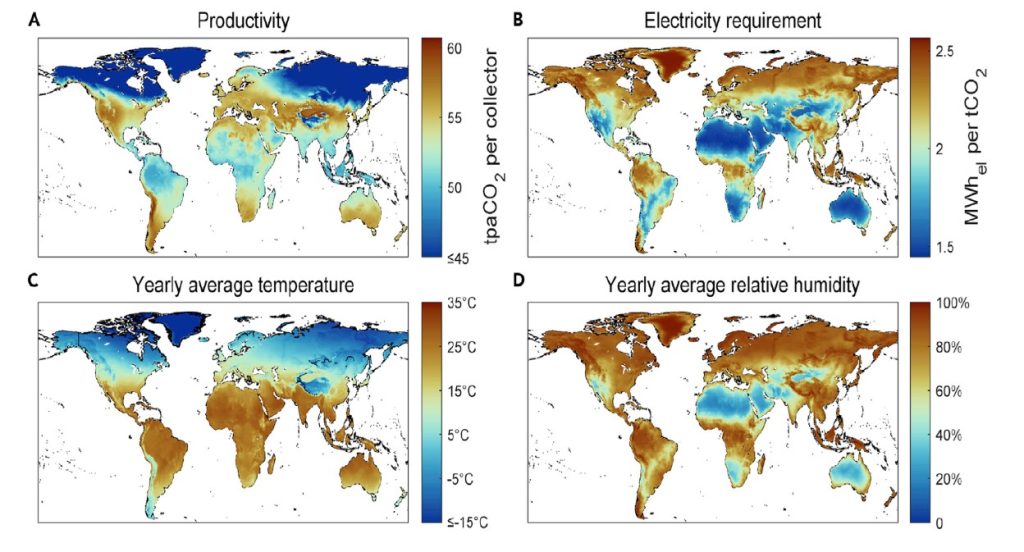I recently wrote an article on the brief history of direct air capture (or DAC), pointing out its roots in antiquity and how it will become a major technology in its role to ameliorate the deleterious effects of climate change.
Therein, I emphasized that the general consensus around the Paris Agreement’s greenhouse gas reduction targets can only be achieved by a global network of DAC facilities operating at the gigaton carbon dioxide (CO2)/year scale by mid-century.
Today, most DAC facilities around the world use adsorption-desorption swing cycles to capture and release CO2 in ambient air, enabled by changes in temperature and pressure. Because global climatic conditions control the temperature and humidity of ambient air, one would expect DAC to be sensitive to the geospatial location of the facility.
This realization begs the question: How does one choose the most cost-effective location to deploy a DAC facility, keeping in mind varying climate conditions around the world? This question was addressed in a recent study published in Cell Press One Earth.
Where best to place direct air capture systems
In brief, there exist multiple steps that must be accounted for in a techno-economic energy and cost analysis of a representative DAC process. Its operation is based upon a commercialized vacuum-pressure-steam-temperature swing system that enables the cycle of adsorption and desorption of CO2 from ambient air utilizing a state-of-the-art solid amine sorbent to accomplish the task.
Because of the high dilution of CO2 in air (420 ppm or 0.042%), the technological and economical feasibility of a DAC facility will depend on its energy intensity and capital and operating costs. As alluded above, the relative humidity of ambient air influences the DAC process because of the competitive adsorption-desorption effects of CO2 and water on the swing cycle energetics and dynamics.
With this background information, a technoeconomic analysis of a DAC system can be assessed by applying a dynamic adsorption-desorption model to ambient air. The outcome of this energy and cost efficiency analysis will be dependent on the input temperature, pressure, and humidity operating parameters.
So, where best to locate a DAC facility knowing the climate around the Earth varies from regions that are cold dry and humid to hot dry and humid?
Depends on geography
Pinpointing this location will also be influenced by the regional variation in the cost of electricity to power the process. Therefore, it is to be expected that key performance assessments, process productivity, and energy requirements — deciders of the commercial viability of a DAC process — will depend on geographic location and seasonal weather conditions.
With the availability of hourly temperature and humidity weather data around the world between 2016 and 2020, it has proven possible to select geographic locations with the best techno-economic productivity and energy performance metrics for operating a DAC facility under different climate conditions.

from Marwan Sendi, et al., One Earth Cell (2022). DOI: 10.1016/j.oneear.2022.09.003
By inspection of the tabulation of results for the global performance and cost metrics of DAC, it turns out that colder and drier regions favor a DAC process, provided temperatures do not fall below 15°C for more than 30 days per year. In this analysis, account has been taken for variations in the cost of electricity (renewable preferred) in different regions, which clearly impact the economics of DAC.
It can be seen from this analysis that for 76% of the land area of the world with favorable climatic environments and electricity at $50 MW/h, the estimated cost of land-locked DAC facilities falls in the range of $320–$540/tCO2. While more than the holy grail $100/tCO2 target, with stable tax credits to increase availability of renewable electricity and utilization of CO2 in application areas, such as manufacturing of commodity chemicals, polymers, and fuels, DAC can become a commercially viable and sustainable enterprise.
It is clear from this analysis that it is vital to understand the energy and economic sensitivity of DAC to climatic temperature and humidity to attract private and public investment. Therefore, in the quest for net-zero emissions targets, DAC locations must be identified that can enable optimal performance.
Knowledge of the climate sensitivity of DAC in this study has revealed that cost-effective deployment of DAC facilities only makes sense in three quarters of the world’s land surface. Collectively, geospatial climate information of this kind is pivotal for governments and policy makers, as well as private and public investors, who believe that a global network of sustainable DAC facilities can save humanity from the existential threat of global warming.
Reference: Marwan Sendi, et al., Geospatial analysis of regional climate impacts to accelerate cost-efficient direct air capture deployment, Cell One Earth (2022). DOI: 10.1016/j.oneear.2022.09.003

















